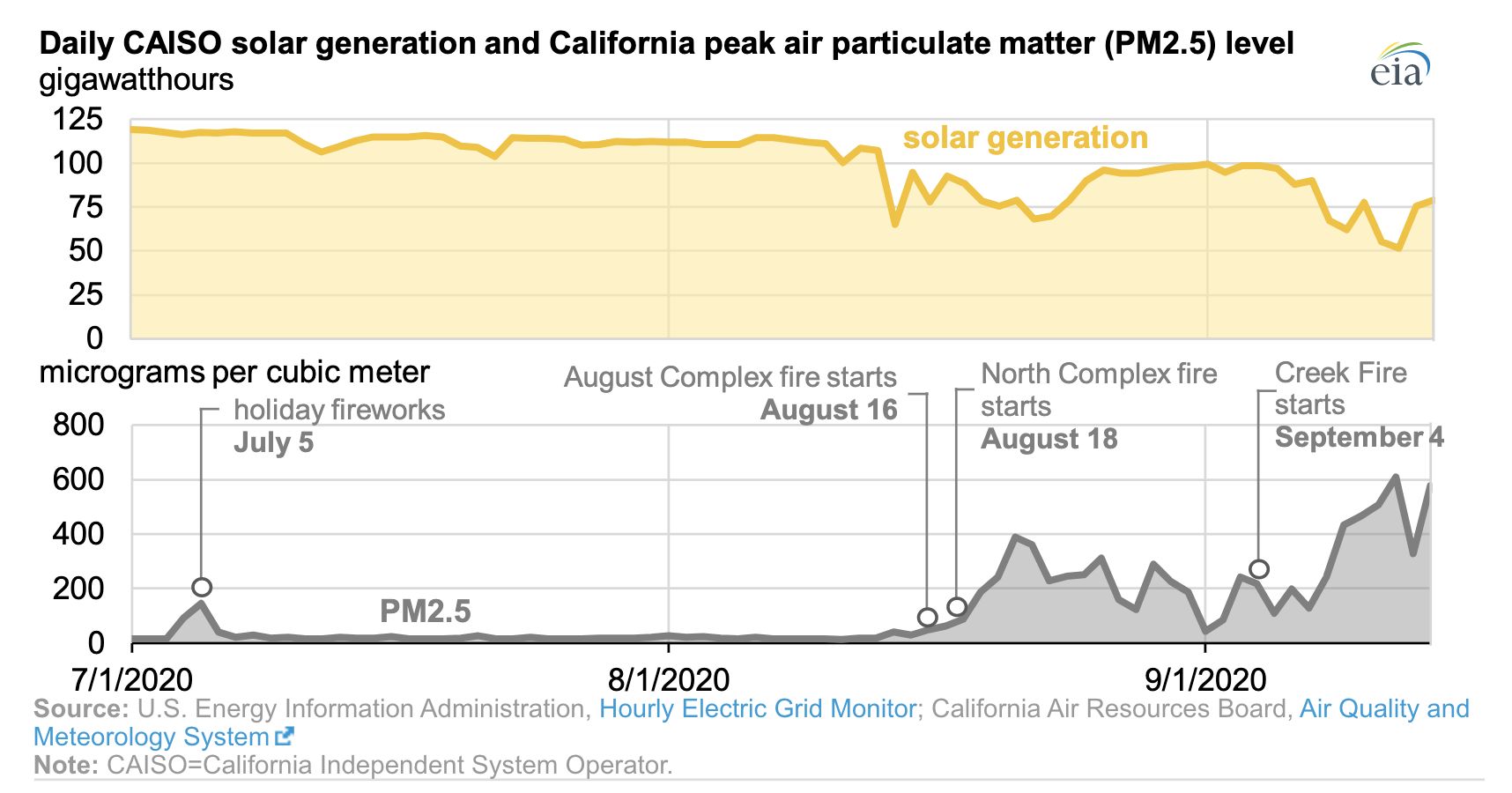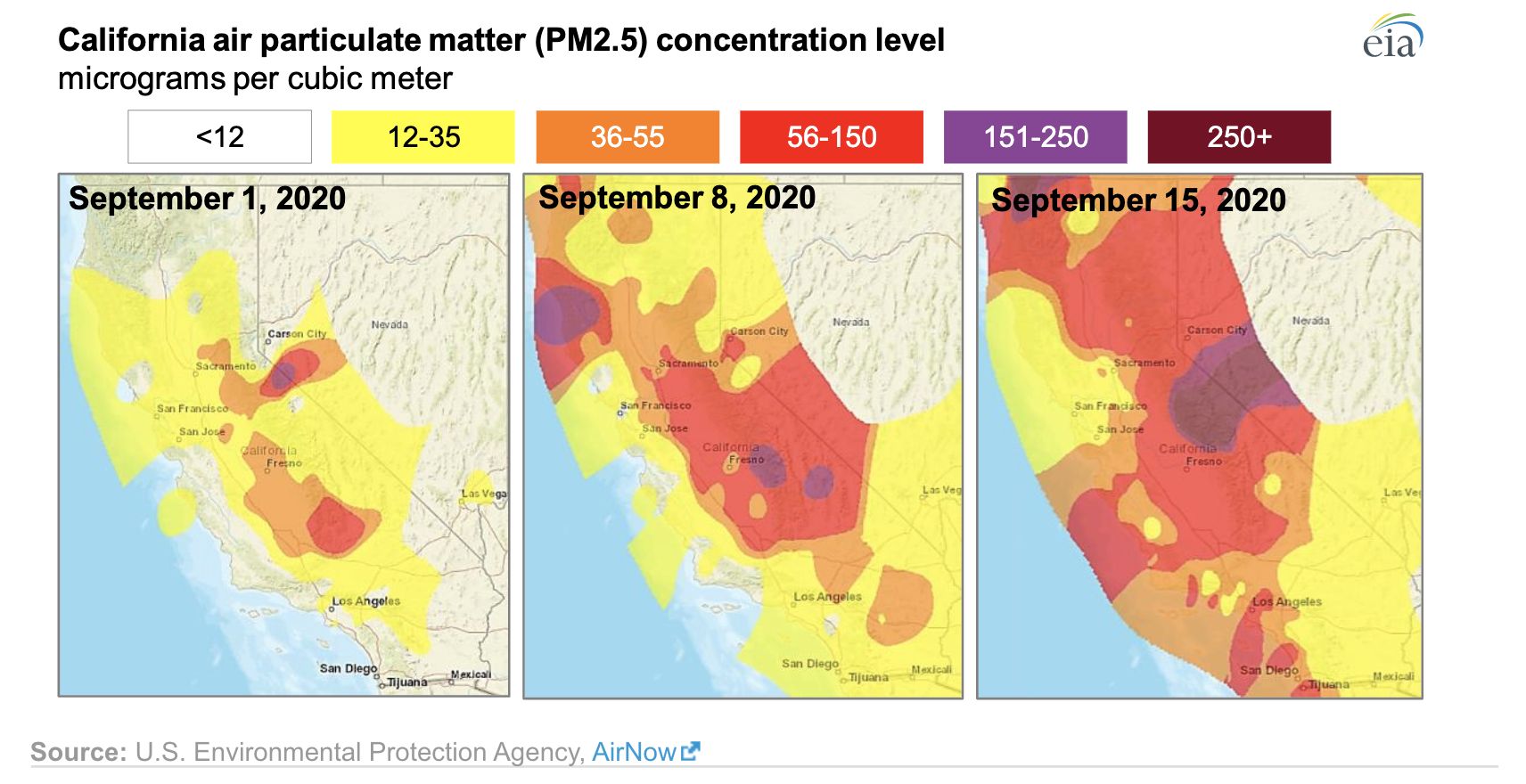The severe wildfire smoke that cast an orange glow over sections of the West Coast this summer also curtailed the productivity of solar panels in California.
Newly released analysis from the Energy Information Administration and the California Independent System Operator shows particulate matter from fires sparked in August and early September blotted out the sun enough to cause quantifiable differences in solar output.
In the first two weeks of September, solar generation on the grid overseen by CAISO, which covers the great majority of large-scale solar in California, dropped about 13 percent year-over-year, even taking into account the fact that California added 659 megawatts of large-scale solar capacity during that period. Production dropped 30 percent from the average output in July 2020 (when output is generally higher than in September).

(Solar output slipped as particulate air matter levels rose this summer. Credit: EIA)
California's recent experience is not the first time researchers have pointed out the challenges that climate change poses to solar energy, ironically one of the technologies held up as an integral tool to coping with the crisis. Last year, analysis from the Massachusetts Institute of Technology suggested warmer temperatures would curtail solar output.
For now, the macro impact to solar from climate-fueled wildfires is limited, said Wade Schauer, research director at Wood Mackenzie Power & Renewables. “No more significant, possibly less so, than tropical monsoon clouds covering Southern California on a hot, humid day,” he told Greentech Media.
Schauer doesn't expect worsening wildfires to significantly affect solar generation in the future. But the effect may become more pronounced as solar grows to make up a larger portion of California’s overall generation, or if the uncertainty impacts deal-making in the sector.
The impact of wildfires has already “become a critical consideration” in underwriting for Capital Dynamics, an asset management firm that owns a 4.6-gigawatt solar portfolio, said Tim Short, the company’s managing director of clean energy infrastructure.
“From an investment perspective, this is primarily a credit risk associated with the service territories of the various [load-serving entities] in California that may be PPA counterparties, but it is also an asset location issue,” said Short. Capital Dynamics has noted impacts from smoke on its projects “in some cases.”
Assessing the impact for California's solar
Fire has always been part of the region's landscape. But record-breaking wildfires have become more common in California in recent years, as climate change has raised temperatures, exacerbated dry conditions that make fires more likely to spark and extended the usual fire season.
Even within that context, 2020 has been a difficult year.
A record 3.7 million acres have burned so far in 2020, according to tracking by the California Department of Forestry and Fire Protection. That’s an area larger than the entire state of Connecticut, and California has hardly entered the period that often brings the most intense fires.
With that fire has come smoke, which has meant hazardous air conditions up and down the coast in recent weeks. In mid-September, the California Air Resources Board logged the highest PM2.5 pollution, a measure of dangerous airborne particulate matter that measures 2.5 micrometers or less, since the agency began tracking that pollutant two decades ago.

This year's wildfires and the corresponding smoke have disrupted life along the West Coast, requiring mass evacuations, exacerbating existing health conditions of residents and claiming the lives of 28 people. It’s unclear how much increasing fires will impact solar output or markets over the long term. California is the United States’ largest solar market and, on any given day, solar is the renewable generation source supplying the most power to the state’s grid.
“There are two things at play: does it affect production enough to change revenues short-term and make a project not profitable? And does it change project assumptions long-term if we expect lots of wildfires?” asked Colin Smith, a senior solar analyst at Wood Mackenzie.
CAISO told Greentech Media in mid-September that smoke had already impacted “not only the direct solar output but [also] solar variability and forecasting.”
The impact may be most acute for residential solar panels. EIA does not include small-scale solar generation in its analysis, but such systems account for about 9.8 GW of capacity in California, compared to the state’s 13 GW of large-scale solar.
“One thing I’ve noticed in my local neighborhood south of Sacramento: The ash and dust has caked on many homes’ rooftop solar panels and likely won’t be cleaned off until our first rain, which is nowhere in sight,” Schauer told GTM. “I’ve got to believe that rooftop solar output, in general, is lower than normal, even on days with little smoke, due to the ash buildup.”
Well-resourced utility-scale projects are more likely to be able to clean panels and get production back to average levels. Still, Smith thinks solar buyers and owners should be thinking about the impacts of climate change as they consider developer assumptions on how much a solar project will produce.
“Developers will not want to at all assume smoke will reduce production since that will only hurt their bottom line,” said Smith. “Buyers and owners, on the other hand, would be smart to integrate that into their assumption.”
But, Smith added, “like most things climate-oriented, they will be slower to react than they should.”




